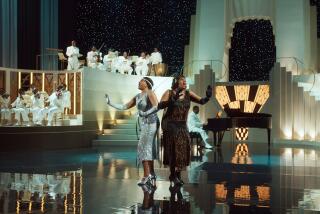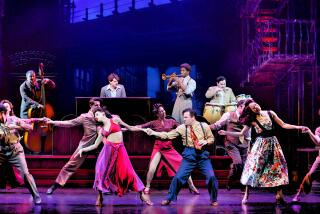Costello is the soundtrack
- Share via
CHICAGO — Playwright-film director Neil LaBute reached down to a table covered with Elvis Costello CDs and pulled out his favorite: “ ‘Imperial Bedroom’ I would always choose,” he said, removing the 1982 disc from its jewel case and slipping it into a boombox.
“I love it,” agreed actor Paul Rudd, who co-starred in LaBute’s play “The Shape of Things” and now the film, which opened last Friday and is scored with Costello songs.
“Just the complete package of that CD is like perfect from beginning to end,” LaBute said, as the ominous tones of “Beyond Belief” seeped out of the speakers. “It’s all so of a piece.”
That LaBute would consider Costello a kindred spirit is no surprise. LaBute’s first two films, “In the Company of Men” and “Your Friends & Neighbors,” were as toxic a one-two punch of male-female duplicity and cruelty as you’re likely to see. Costello cemented his early Angry Young Man reputation spitting out such lyrics as “Sometimes I think that love is just a tumor/You’ve got to cut it out,” from the manic “Lipstick Vogue.”
Both artists were said to mellow over time, LaBute with “Nurse Betty” and “Possession,” Costello with forays into country, classical and old-style pop songcraft.
“The Shape of Things,” with its no-frills look and stinging sexual politics, could be viewed as a back-to-basics move a la Costello’s “Blood and Chocolate” or “Brutal Youth.” Snippets of “Lipstick Vogue” and other Costello songs play between the 10 scenes of the new movie, the story of a college nerd (Rudd) whose beautiful art-student girlfriend (Rachel Weisz) gives him an aggressive makeover. The music is different from the stage version, in which LaBute assaulted theater-goers with rock-concert-level Smashing Pumpkins music.
His reasons for the switch illustrate basic differences between what works on the stage and on the screen -- and had nothing to do with playwright Harold Pinter’s tender ears. Pinter, you see, had a less-than-ideal reaction to the Pumpkins’ “Cherub Rock” being blasted before a line of dialogue had been delivered at one of the opening New York performances.
“My heart’s racing, the adrenaline’s going because all the critics are out there, the show has started, and I just saw a shadow on the wall, thinking, ‘That’s not supposed to be there,’ ” Rudd recalled. “A guy just came storming out, looked at me ... and I recognized him as Harold Pinter, and then his wife, Nancy, just came scuttling by, following in his footsteps by about three seconds, and then they stormed out, and literally I had to turn and walk on stage and start the show.”
LaBute considered the walk-out “a badge of honor.” But he had specific reasons for cranking up the Pumpkins songs between each of the play’s scenes.
“I wanted to create the aura of the sound but also just use the actual sonic blast of it, so the audience, at the place where they normally might kind of rest and talk to each other at a blackout, they were just enveloped in this noise, and they couldn’t talk about the plot or anything like that to themselves,” LaBute said. “So there was never a moment of rest.”
Plus, the breaks between scenes were relatively long as cast members changed clothing.
“Because of that I needed a good portion of a song, whereas when you’re just cutting from scene to scene in a film, those songs couldn’t even get started,” the director said. “So I had to look for something that could make its point really quickly, and Costello is so great at these very punchy, very hummable hooks, and he also writes great lyrics about relationships with an acid pen. He made complete sense.”
“The Shape of Things” opens with “Lovers Walk,” sort of a Bo Diddley-in-a-B-movie track (from 1981’s “Trust”) that warns, “Be on caution where lovers walk.” Only on that song and the closing “Tear Off Your Own Head (It’s a Doll Revolution)” do you actually hear lyrics.
Otherwise there are what LaBute describes as “just these little blips, these 10-second pieces, like the scream at the beginning of ‘Man Out of Time,’ and they’re beginning to build as we go along. That was important to have music that even if you didn’t recognize it, it was all of a piece.”
More to Read
Only good movies
Get the Indie Focus newsletter, Mark Olsen's weekly guide to the world of cinema.
You may occasionally receive promotional content from the Los Angeles Times.







